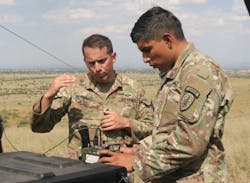Southwest Research to help measure HF radio waves to boost communications spectrum situational awareness
ARLINGTON, Va. – U.S. military researchers needed a company to measure HF radio waves to improve warfighter radio spectrum situational awareness. They found their solution from Southwest Research Institute in San Antonio, Texas.
Officials of the U.S. Defense Advanced Research Projects Agency (DARPA) in Arlington, Va., announced a $38.9 million contract to Southwest Research last week for the Cancun program, which seeks to create distributable nodes to measure high-frequency radio waves for improved warfighter situational awareness.
The low size, weight, power, and cost (SWaP-C) of these nodes will enable cost-effective wide-area deployments. The Cancun nodes will measure the state of the ionosphere using a sounding function, as well as record and relay portions of the HF radio band for analysis.
The primary challenge in Cancun is coordinating many Cancun units deployed over distances farther than 620 miles. Cancun will provide a command and control (C2) network and planning tools to address this challenge.
The C2 hardware solution may involve existing wired or wireless infrastructure. Communications latency will be an important parameter for this network. The mission planning tool will be developed with warfighter input to optimize functionality.
Technologies developed under the Cancun program will move over to the U.S. military services. For more information contact Southwest Research Institute online at www.swri.org, or DARPA at www.darpa.mil.
About the Author
John Keller
Editor-in-Chief
John Keller is the Editor-in-Chief, Military & Aerospace Electronics Magazine--provides extensive coverage and analysis of enabling electronics and optoelectronic technologies in military, space and commercial aviation applications. John has been a member of the Military & Aerospace Electronics staff since 1989 and chief editor since 1995.
